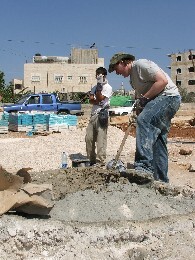Palestine Report 30 July 2005

An international volunteer mixes cement (Maureen Clare Murphy)
That was the first time Shawamreh’s house in Anata, a village near Jerusalem, was destroyed by Israeli bulldozers. It would happen three more times. He tells the story while sitting in the fifth incarnation of the house, which currently doubles as a peace and activism center. The walls are hung with pictures of Shawamreh being beaten and his family in tears as a reminder of the history of the building.
Shawamreh is now a fieldworker with the Israeli Committee Against House Demolitions (ICAHD), and for the last week has been helping to direct some twenty-three international volunteers with ICAHD’s summer workcamp, and some 30 employed specialized workers from Anata village, who are building another destroyed house in the village. Like Shawamreh, Arafat Moussa Hamdan’s house was destroyed because it was built without a permit. Both Shawamreh, who says he has paid $15,000 to the Israeli government and various surveyors and contractors in his efforts to obtain a permit, and Hamdan, who says he has spent NIS2,000 (about $450) in his various attempts to acquire a building permit, have been given varying excuses from the Israelis each time they apply.

A Palestinian laborer works on one side of the house (Maureen Clare Murphy)
After collecting 400 signatures from the various homeowners in the village, and confident that the two names missing from his papers would be found amongst those 400 signatures, Shawamreh was merely told by the Israeli Civil Affairs office that they had lost his file, and so they couldn’t verify the two names.
Both Shawamreh and Hamdan believe that the “Kafka-esque system” (as Shawamreh puts it) of destroying houses for lack of never-granted permits is “just an excuse to take the land”, as Hamdan puts it. Figures from the Israeli human rights group B’Tselem show that between 1999 and 2004, 343 houses in East Jerusalem were destroyed by the Jerusalem municipality or the Israeli interior ministry because they lacked a permit.
Ziad Hammoury, general director of the Jerusalem Center for Social and Economic Rights (JCSER), says that because of this system, “most people build without a license, because they have no other options. The Israelis push them into a corner.”
To build, Hammoury explains, “you need to submit for a permit, [a process that] takes three to five years. And it will cost $25,000 to $30,000 just to obtain such a license to build. Of course, in these hard conditions, it is difficult for people [to get a license].” And very few people actually receive building permits.
Palestinian East Jerusalemites, with their ever-growing population, could build outside Israel’s Jerusalem boundaries, Hammoury continues, but then “they are threatened with confiscation of their ID cards.” This is because, according to Israeli law, East Jerusalemites must prove that their “center of life” is in the city to keep their IDs. Thus, building in Jerusalem without a permit “is the only way [for Palestinians] to continue their existence in East Jerusalem.”
Shawamreh is aware of the very real possibility of the peace center, or one of the twenty homes that ICAHD has rebuilt, will again be destroyed by Israeli bulldozers. Explaining that the rebuilding project is not for humanitarian purposes, Shawamreh says, “we are building as a [means of] resisting the occupation.” The cooperation of Israeli and Palestinian activists is intended to send the message “that we refuse to be two nations as enemies.”
However, ICAHD’s International Coordinator Lucia Pizarro concedes that there is a lack of interest amongst Israelis to participate in the annual summer workcamps. Pizarro explains, “we give them a discount” to the $500 fees, “but very few come.” However, Shawamreh says that thousands of activists from abroad want to participate in the camp, but a lack of accommodation limits the participation to around two dozen.
The nature of the rebuilding project also limits ICAHD’s fundraising options, as a grant they received from the European Union stipulates that the money can’t be used for illegal purposes. For the summer workcamp they rely on private donations from the international community.
“Only with strong pressure from the international community will anything change,” says Pizarro. “The purpose of our summer workcamp is political. It’s a symbol of civil disobedience. The law of civil occupation is a law that should not be obeyed.”
And there is also personal satisfaction in the end. “The moment we open the house, it’s amazing,” says Pizarro. Shawamreh is looking forward to seeing Hamdan, his wife, and their five children (a sixth is on the way) move back into their house.
“At the end of the week we’ll give them the key to their house. I hope it will be with them forever.”
Related links:
This article was first published on 27 July 2005 in Palestine Report Online, a project of the Jerusalem Media and Communications Center in Jerusalem, and is reprinted with permission. Palestine Report Online is a continuation of the print Palestine Report, which was established over twelve years ago as a means of informing English-speakers about Palestinians and their daily lives in the context of the ongoing Israeli-Palestinian conflict. Also in this week’s edition: PR reports on fears in Gaza and visits a holocaust museum in Nazareth.




